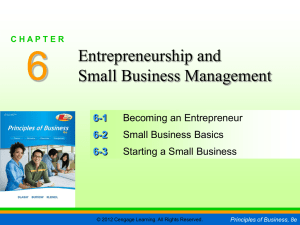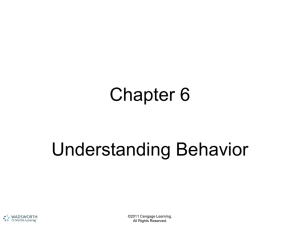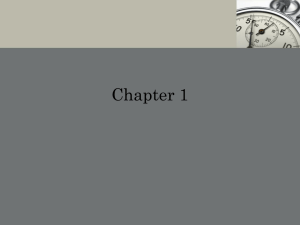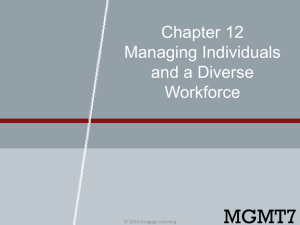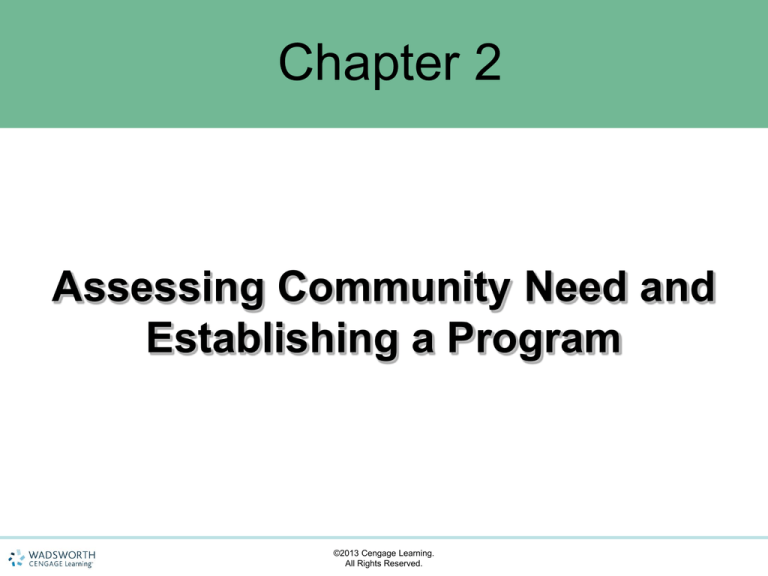
Chapter 2
Assessing Community Need and
Establishing a Program
©2013 Cengage Learning.
All Rights Reserved.
Chapter Objectives
• List the factors that influence the need for
child care.
• Name the various types of child care
used by families.
• Identify information that will help you
determine the types of child services
needed now and in the future.
©2013 Cengage Learning.
All Rights Reserved.
Chapter Objectives
• Use your knowledge of data collection
methods and resources for assessing the
need for child care in your area.
• Compare and contrast mission and
values statements.
• Use core values to develop values
statements.
• Describe characteristics of different types
of centers.
©2013 Cengage Learning.
All Rights Reserved.
Assessing the Need
• Needs Assessment includes…
– number of families and children
– socioeconomic level of families
– ages of children to be served
– type of service families prefer
©2013 Cengage Learning.
All Rights Reserved.
Assessing the Need
• How Do You Find Out About Need?
– questionnaires
– use of telephone surveys
– small-group meetings
©2013 Cengage Learning.
All Rights Reserved.
Discussion Question
1. What do you think are the
advantages and disadvantages of
using a telephone survey for
assessing the need of child care in
your target community?
©2013 Cengage Learning.
All Rights Reserved.
Determining Program
Philosophy
• The basis for choosing program
philosophy is…
– assumptions about how children learn
– values of the program planners and families
involved
– views of the planners regarding basic issues
in education
©2013 Cengage Learning.
All Rights Reserved.
Philosophy:
Based on How Children Learn
• How children learn falls into three major
categories
– environmental
– maturational
– interactional
©2013 Cengage Learning.
All Rights Reserved.
Philosophy:
Based on How Children Learn
• Environmental
– Assumes the environment and teachers have
the most influence on children’s growth.
• Maturational
– Assumes there is an internal driving force that
leads to child development.
• Interactional
– Assumes that learning results from the
dynamic interaction between the cognitive
and affective systems, and the environment.
©2013 Cengage Learning.
All Rights Reserved.
Philosophy:
Content Versus Process
• Content subscribers support notion that the
goal of education is to provide children with
content that enables them to succeed in
school.
– Focus is on preparing for next step in schooling
– Achievement is evaluated by relating each
child’s progress to norms or to grade level
– Goal of education is upper movement of the child
to higher levels of intellectual competency
©2013 Cengage Learning.
All Rights Reserved.
Philosophy:
Content Versus Process
• Process subscribers support the notion
that problem-solving skills are more
important than content mastery.
– Autonomy, collaboration, and cooperation are
valued
– Years in school are considered an integral
part of life itself
– Major goal of education is for children to
become autonomous problem solvers
©2013 Cengage Learning.
All Rights Reserved.
Philosophy:
Content Versus Process
• Process subscribers support the notion that
problem-solving skills are more important than
content mastery (continued).
– Schooling is not viewed as either preparation for
later school or preparation for life
– Achievement is based on the ability to cope with the
here and now
©2013 Cengage Learning.
All Rights Reserved.
Types of Programs
•
•
•
•
•
•
Not-for-Profit
Individual Cooperative
Agency-Sponsored
Government-Sponsored
Public School-Sponsored
Campus Child Care
©2013 Cengage Learning.
All Rights Reserved.
Types of Programs
•
•
•
•
•
•
•
Privately Sponsored Not-for-Profit
Profit-Making (Proprietary)
Independent Owner
Corporate Systems
Employer-Sponsored
Military
Family Child Care Homes
©2013 Cengage Learning.
All Rights Reserved.
Individual Cooperative
Programs
• Cooperative programs are often called
parent co-ops:
– Owned and operated by group
– Parents expected to help in classroom
– Usually has one or two paid staff members
– Costs are kept at a minimum
– Tuition is typically lower than in other centers
– Most are half-day programs
©2013 Cengage Learning.
All Rights Reserved.
Agency-Sponsored Programs
• Many not-for-profit early childhood education
programs are sponsored by community agencies
(i.e. church groups, service agencies, United Way)
– May be full or half-day enrichment programs
– Found in both rural and urban areas
– Can serve both low-income and middle-income
families
– Sometimes receive partial support from sponsor but
obtain remaining support from tuition, government
funds, and/or grants
©2013 Cengage Learning.
All Rights Reserved.
Government-Sponsored
Programs
• Head Start is the best known federal
government-sponsored program.
– Funding for HS may go to public school
systems, universities, and public or private
not-for-profit agencies
– HS programs may be center based or home
based
– May provide full-time or half-time and usually
serves 4 year olds
– Early Head Start serves infants/toddlers
©2013 Cengage Learning.
All Rights Reserved.
Public School-Sponsored
Programs
• Mostly Pre-K programs and many in public
schools
– Funded through local or state tax monies or
other public funds
– Full or half-day programs staffed by people
hired through public school
– Typically housed in public schools
– Practices tend to focus on academic success,
school readiness, and standardized testing
©2013 Cengage Learning.
All Rights Reserved.
Campus Child Care Programs
• Lab schools and child care programs for children
of students, faculty, and staff.
– Found on college campuses
– May be sponsored and subsidized by
college/university or by government funds
– Provide facilities for research, observation, and
teacher training
– May be full or half day
– Program hours are flexible to accommodate
students’ course schedules
©2013 Cengage Learning.
All Rights Reserved.
Privately Sponsored NFP
Programs
• Centers are sponsored by large industries,
hospitals, and apartment complexes.
– Offer services for the children of their employees
and residents
– Centers are set up for comfort and convenience of
employees and residents
– Hours are flexible
– Fees may be on a sliding scale
– May be a part of the employee benefit package
– May have Dependent Care Assistance Program
©2013 Cengage Learning.
All Rights Reserved.
Independent Owner
• Program that is owned and operated by an
individual or small group.
– Tuition is usually the only source of income
– Owners frequently have budgeting and financial
problems and could receive money from other
sources including state funding
©2013 Cengage Learning.
All Rights Reserved.
Independent Owner
• Program that is owned and operated by an
individual or small group (continued)
– Operation rarely makes a profit because of the
high cost of operating a quality program
– Owning multiple centers can result in quantity
buying and shared services that reduced cost
per child and increases possibility of making a
profit over and above operating expenses
©2013 Cengage Learning.
All Rights Reserved.
Corporate Systems
• Large child care chains that are operated
by a parent company that develops a
prototype and sets up a number of centers
throughout the state/region or across the
nation.
– Some companies have gone public
– Operate under central administration that
furnishes financial background
©2013 Cengage Learning.
All Rights Reserved.
Corporate Systems
• Large child care chains that are operated by
a parent company that develops a prototype
and sets up a number of centers throughout
the state/region or across the nation (continued)
– Center is publicized by identifiable slogans,
logos, brochures, and advertisements
– Franchising may fall under this category
– Knowledge Learning is an example of a
corporate system
©2013 Cengage Learning.
All Rights Reserved.
Employer-Sponsored Programs
• The child care center is supported by an
employer
– Some are operated by large management
organizations
– May offer subsidized tuition and/or reduced
fees
– May be able to give employees better wages
because of reduced operating costs paid by
employer
©2013 Cengage Learning.
All Rights Reserved.
Military Programs
• Department of Defense (DOD) operates child
care programs at military installations across
the country.
– Each branch of military operates its own child care
services but must follow mandates in Military Child
Care Act of 1989
– May contract with off-installation centers to
guarantee spaces for DOD children
©2013 Cengage Learning.
All Rights Reserved.
Military Programs
• Department of Defense (DOD) operates child
care programs at military installations across
the country (continued)
– Financed by a combination of government
appropriations and sliding scale parent tuition
fees
– May be full-day center-based care, part-day
preschools, drop-in care, evening and weekend
care
©2013 Cengage Learning.
All Rights Reserved.
Family Child Care Homes
• Family child care is where a small group of
children is cared for in the home of a child
care provider.
– Popular for infants and toddlers, but care for
all ages including school-age
– May be an employee of a system but most
often operates independently contracting
directly with families
©2013 Cengage Learning.
All Rights Reserved.
Chapter Summary
• Starting a center includes…
– conducting a needs assessment
– developing a philosophy
– Deciding on the type of program operations
• Time and energy must be invested before
financial support is available and before a
program can begin to deliver service to
children and families.
©2013 Cengage Learning.
All Rights Reserved.




